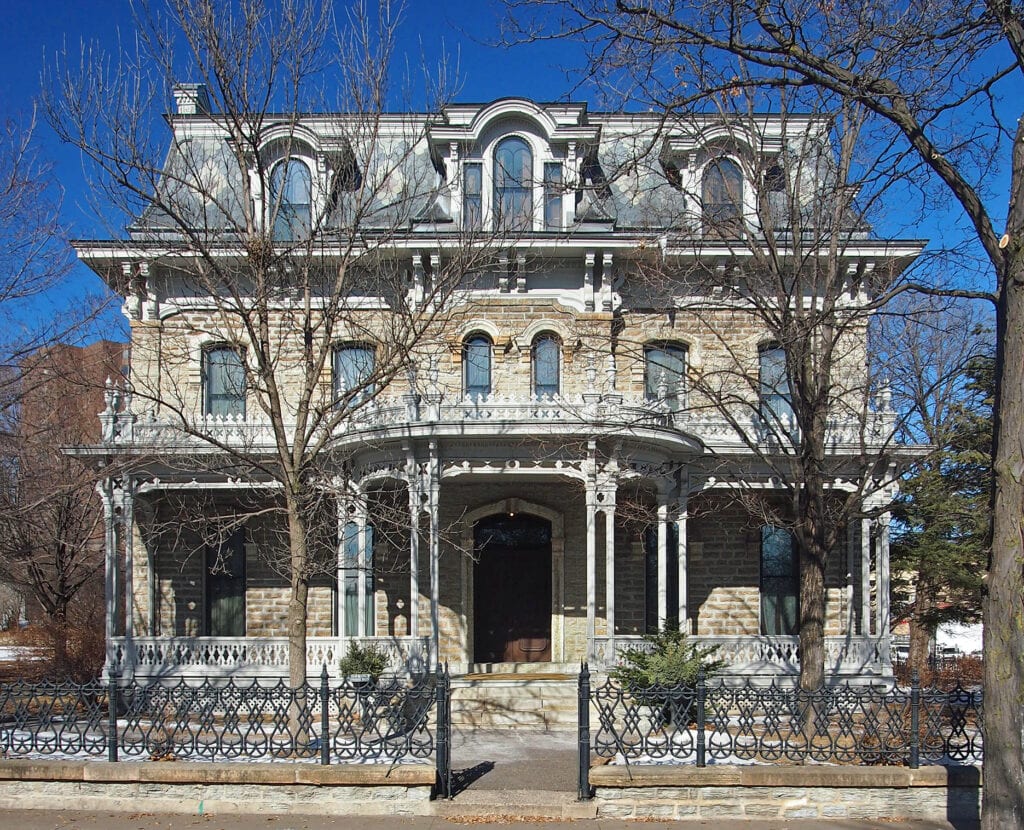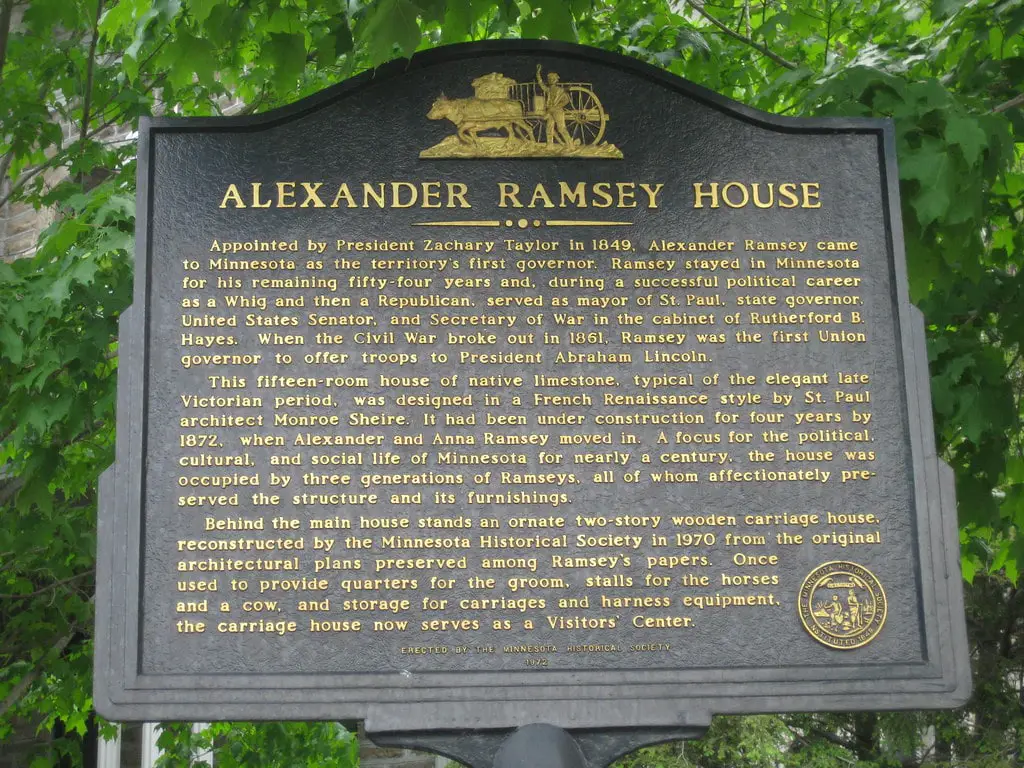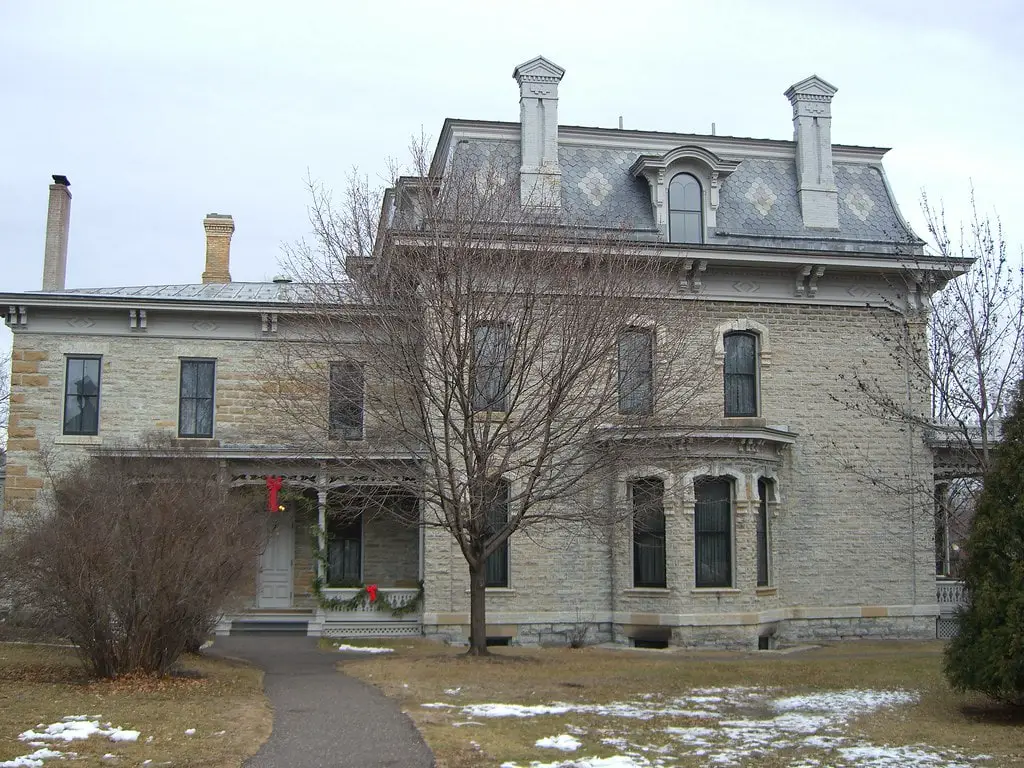The Historical Significance of the Alexander Ramsey House
Situated in the core of Saint Paul, Minnesota, the Alexander Ramsey House symbolizes the profound historical significance and architectural splendor of the 19th century.
Built in 1868, this historic house museum was once the residence of Alexander Ramsey, a key figure in Minnesota’s early political landscape.
Today, it is a portal into the past and a significant landmark on the National Register of Historic Places since 1969.
The house is located at 265 Exchange Street South in Irvine Park, one of the first fashionable neighborhoods in Minnesota.
Monroe Sheire and John Summers crafted their architectural design, a prime example of the Second Empire style.
This style, characterized by its mansard roofs and ornate details, was popular in the United States during the late Victorian era.
The Ramsey House’s inclusion in the Irvine Park Historic District further underscores its importance as a piece of Saint Paul’s architectural heritage.
Its well-preserved Victorian features immediately strike visitors to the house.
The interior boasts carved walnut woodwork, marble fireplaces, and crystal chandeliers, transporting guests to a bygone era of elegance and luxury.
The home also showcases many original furnishings, providing a glimpse into the lifestyle of the Ramsey family.
These elements combined make the Alexander Ramsey House a significant cultural and historical asset for Saint Paul and Minnesota.
In addition to its architectural and historical significance, the Alexander Ramsey House has become a vibrant center for community engagement and education.
It offers a range of activities and events throughout the year, making it a key destination for things to do in Saint Paul, Minnesota.
From guided tours that delve into the life and times of Alexander Ramsey and his family to special programs like “A Victorian Christmas at the Ramsey House,” the museum brings history to life for visitors of all ages.
The journey of the Alexander Ramsey House from a family residence to a museum reflects the broader narrative of Saint Paul’s evolution over the centuries.
As the house continues to be preserved and celebrated, it stands as a symbol of the city’s rich heritage and enduring legacy.
Alexander Ramsey and His Legacy
Early Life and Political Ascendancy
Alexander Ramsey’s journey began in Pennsylvania, where he was born in 1815. His political career took off in his home state before he ventured westward.
In 1849, a pivotal year, he was appointed the first governor of Minnesota Territory, a role that began his profound impact on the region.
Ramsey’s political influence further expanded when he became the second state governor of Minnesota, a position that cemented his status as a key figure in the state’s early governance.

Diverse Political Roles
Beyond his gubernatorial duties, Ramsey’s political repertoire was diverse. He served as the mayor of St. Paul, bringing local insights to his leadership.
His influence extended to the national stage as a U.S. Senator, a role that allowed him to shape broader American policies.
Additionally, his appointment as the U.S. Secretary of War under President Rutherford B. Hayes highlighted his versatility and capability in various governmental roles.
Complex Legacy
Ramsey’s legacy is multifaceted, marked by both achievements and controversies. His role in the Dakota War of 1862 is particularly contentious.
His decisions during this period had a lasting impact on the Dakota and Ojibwe people, leading to their forced removal from their lands.
This aspect of his legacy is a subject of ongoing discussion and reflection, illustrating the complexities of historical figures and their impact on Indigenous communities.
Architectural and Interior Highlights of the Ramsey House
Victorian Architectural Mastery
The Alexander Ramsey House, completed in 1872, is an exquisite example of Second Empire architecture, a style that peaked during the Victorian era.
Architects Monroe Sheire and John Summers masterfully designed the house, which has distinctive features like the mansard roof and elaborate window treatments.
These architectural elements define the house’s external appearance and reflect the era’s aesthetic preferences.
A Glimpse into Victorian Luxury
The interior of the Alexander Ramsey House is a showcase of Victorian elegance. The house is adorned with carved walnut woodwork, a hallmark of the period’s craftsmanship.
Marble fireplaces in the home add to its grandeur, creating a warm and inviting atmosphere.
Crystal chandeliers further enhance the house’s luxurious feel, casting a soft glow that illuminates the rich details of each room.

Original Furnishings and Innovations
The house still contains many original furnishings, offering an authentic glimpse into the Ramsey family’s life.
These pieces include expensive Renaissance-revival furniture from the prestigious A.T. Stewart Company Store in New York.
The family’s choice of furnishings reflects its social status and taste for fashionable decor.
Additionally, the house was ahead of its time with innovations like hot water radiators, gas lights, and hot and cold running water, showcasing the technological advancements of the era.
The Ramsey Family and Their Life in the House
The Ramsey Residence: A Social Hub
Alexander Ramsey House, completed in 1872, was more than just a home; it was a social epicenter for the Ramsey family and the burgeoning community of Saint Paul.
The family’s residence here spanned several decades, during which time they witnessed numerous social events and gatherings that reflected the era’s customs and traditions.
The house, with its spacious parlors and elegant dining rooms, hosted various social events, making it a notable landmark in Saint Paul’s social history.
Personal Milestones and Family Legacy
One of the most significant events in the house’s history was the marriage of the Ramseys’ daughter, Marion, in 1875.
This lavish affair showcased the family’s status and the house’s capacity for grand celebrations.
The family’s commitment to preserving their history is evident in the retention of numerous personal belongings, ranging from clothing to letters, offering a unique insight into their daily lives and era.
Transition to a Museum
The house’s transformation from a private residence to a public museum began after Anita, Alexander Ramsey’s last surviving granddaughter, died in 1964.
This transition marked a new chapter in the house’s history, turning it from a family home into a repository of cultural and historical artifacts.
The Minnesota Historical Society took over the stewardship of the house, ensuring its preservation and opening its doors to the public for educational and historical exploration.

The Museum Experience and Public Tours
Guided Tours and Educational Programs
The Alexander Ramsey House, managed by the Minnesota Historical Society, offers a range of guided tours and educational programs.
These tours give visitors an in-depth look at the house’s history, architecture, and family legacy.
The educational programs are designed to engage visitors of all ages and offer insights into the Victorian era and Minnesota’s historical context.
Special Events and Thematic Tours
In addition to regular tours, the house hosts special events and thematic tours throughout the year.
These events often focus on aspects of Victorian culture or significant periods in the house’s history.
For example, the “Victorian Christmas at the Ramsey House” event recreates the Ramsey family’s holiday traditions, offering visitors a festive and historical experience.
Accessibility and Community Engagement
The Minnesota Historical Society has made concerted efforts to ensure the house is accessible to a wide audience.
This includes offering virtual tours for those who need help to visit in person and organizing events that cater to diverse interests and age groups.
The society’s commitment to community engagement has made the Alexander Ramsey House a historical landmark and a living center for cultural education and community activities.
Educational and Cultural Programs at the Ramsey House
Embracing Education Through History
The Alexander Ramsey House has become a beacon of educational excellence, offering various programs that delve into the intricacies of Victorian life and Minnesota’s rich history.
These educational initiatives cater to a diverse audience, ranging from school children to history enthusiasts.
The programs are meticulously designed to provide an immersive experience, allowing visitors to step back in time and understand the historical context of the 19th century.

Hosting Special Events and Activities
The Alexander Ramsey House organizes special events and activities throughout the year, highlighting aspects of Victorian culture and the Ramsey family’s lifestyle.
These events include summer guided tours, which offer a detailed exploration of the house and its history during the warmer months.
The holiday programs, particularly popular among visitors, showcase the home in festive decor and show how the Ramsey family celebrated occasions like Christmas.
Field Trips and Group Tours
Alexander Ramsey House is a popular destination for field trips, providing educational groups with a unique learning experience.
These visits are tailored to complement school curriculums, focusing on various historical and cultural aspects.
Group tours are also available, allowing organizations and private groups to explore the house’s history more intimately.
Preservation Efforts and Future Plans
Ongoing Preservation and Restoration
Preserving the Alexander Ramsey House is an ongoing effort involving meticulous care and attention to detail.
The Minnesota Historical Society, responsible for the house’s upkeep, undertakes regular restoration projects to maintain its structural integrity and historical accuracy.
These efforts ensure that the house remains a true representation of the Victorian era, preserving its architectural and historical significance for future generations.
Future Exhibits and Restoration Projects
Looking to the future, plans are underway to introduce new exhibits that will further enhance the visitor experience.
These exhibits aim to provide deeper insights into the Ramsey family’s life and the broader historical context of their time.
Additionally, restoration projects are planned to refurbish certain areas of the house, ensuring that every corner of this historic landmark is preserved to the highest standards.
Community Support and Funding
The preservation and enhancement of the Alexander Ramsey House rely heavily on community support and funding.
Contributions from individuals, organizations, and government grants play a crucial role in maintaining and improving the house.
The Minnesota Historical Society actively seeks support to preserve this important piece of Minnesota’s heritage and ensure that the Ramsey House remains a vibrant center of historical and cultural education.
